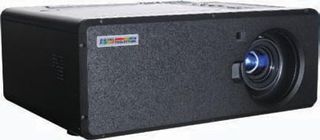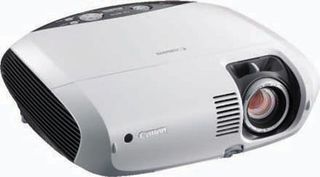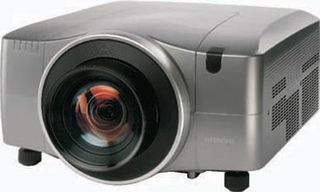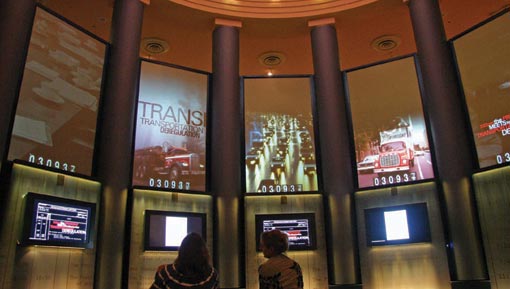Projection for Digital Signage
While the ubiquitous flat panel is the mainstay of digital signage, when larger screen sizes are needed (like the entire side of a building), or when unusual size screens are needed, projection is great. And there is more out there than you think. Alan Brawn, of Brawn Consulting, recently estimated that about 25percent of all digital signage is being done with projectors as opposed to flat panels.
Design and Production Inc. (www.d-and-p.com) recently completed an extensive multi-million dollar renovation of the Carter Presidential Library and Museum in Atlanta, GA, using 13 Digital Projection projectors. The large rotunda showcase uses six Digital Projection TITAN HD-600 projectors to display 13-foot tall portrait- oriented images of a day in the life of Carter's presidency.
- When you think about it, there are so many applications where a projector has an advantage over a flat panel:
- Flat panels are limited in size. To project onto a building or to project anything above about 60 inches diagonal (there are 60-inch and even larger flat panels — even up to over 100 inches, but those large-size LCD panels are expensive) projectors can be the ideal solution.
- Projecting onto uneven surfaces such as curves and relief surfaces.
- Projecting onto the floor or ceiling.
One drawback to using projectors for digital signage has been that their bulbs can be expensive and need to be replaced periodically. If a typical projector bulb has an average life of 1000 hours, and in the “worst case scenario” you’re running digital content 12 hours a day 7 days a week, that’s only about 12 weeks of operation before the bulb needs to be replaced. Bulbs can cost as much as $300 apiece for higher-lumen projectors, and may need an on-site technician to install them. So a lot of networks have been reluctant to use projectors. But, of course, most installations are not using the projectors anything approaching 24/7, so there is still a lot of mileage to be had from conventional mercury lamp projectors. And note that many manufacturers are now releasing conventional mercury lamp projectors with “eco” modes for greatly improving lamp life and lowering power consumption.
The LED-light engine projector solves the lamp replacement problem for applications on a tight budget and where high lumen projection is not needed. (LED-light engine projectors are getting brighter, but there is really nothing in this category yet that achieves more than about 2000 lumens.) Texas Instruments DLP has been developing video projector prototypes that use LED phosphors as the light source in place of a conventional lamp, but the units available from DLP projector manufacturers were a bit slow in coming to market until this year, because of standard economy of scale factors, and also because the LED-light source projectors are not yet as bright as conventional projectors. But they are getting better and brighter all the time, and at InfoComm 2010 we’ll see a variety of LED-light engine DLP projectors that are available now. (Note that there is one laser and LED hybrid light source projector being marketed now — the Casio GREEN SLIM projector.)
Christie Digital’s MicroTiles, video cubes that use an LED-light engine DLP projector as the light source, are important because they represented, when they were introduced last fall, the first real introduction of a product for the commercial AV market that featured a “lampless” projector. The Christie MicroTiles have made a big impact in the digital signage market.
Also, look to Norwegian projector manufacturer projectiondesign to roll out projector Porsches while a lot of companies crank out Chevy rental cars in the market share wars. projectiondesign has debuted its latest innovation in projection technology with the iFR12 remote light source (RLS) projector. The RLS that we’ll see at InfoComm relocates the lamps away from the projector to a rack-mount enclosure up to 30m away from the projector head, which is intriguing as heat issues and noise issues both go away.
There are so many video projectors available on the market, and most of them are appropriate for digital signage of some kind. We’ve rounded up here just a tiny glimpse of some of the new projectors you can find on the floor at InfoComm this year.
CASIO GREEN SLIM PROJECTORS

Earlier this year, Casio America, Inc. announced the creation of a mercuryfree laser and LED hybrid light source that was capable of high-brightness projection for use in next-generation projectors. Developed under the company’s “clean and green” concept, the new projectors eliminate the need for mercury bulbs with the production of a long-lasting light source. Casio is showcasing its GREEN SLIM line of projectors, the world’s first mercury-free high-brightness data projectors, during InfoComm 2010 at Booth #C5870.
GREEN SLIM projectors are not only eco-friendly and affordable, but also versatile as they can be used for many applications, including digital signage, education, business, and home entertainment. While utilizing the GREEN SLIM projectors, users will encounter a better projection experience thanks to the many benefits of the hybrid light source.
GREEN SLIM projectors integrate a variety of signage applications and display electronic messages in any location to help organizations communicate effectively to target audiences without sacrificing image integrity or quality.
DPI E-VISION WXGA 600

Digital Projection International (DPI) has announced the launch of its new high-brightness, highvalue E-Vision projector line. The E-Vision WXGA 600, the first in the series to be unveiled, delivers a remarkably affordable precision projector with the imaging fidelity of Texas Instruments’ DLP technology. With numerous lens options, swappable color wheels, and advanced color controls, the 6000-lumen E-Vision WXGA 600 continues DPI’s legacy of developing powerful, efficient displays for any commercial application imaginable.
The E-Vision’s high lumen output excels in ambient light conditions, allowing it to produce bright, saturated imagery in well-lit venues. In public-space digital signage applications, where many showcase spaces cannot prohibit ambient light, the E-Vision supplies agencies and integrators alike an opportunity for highimpact messaging without expensive infrastructure alterations. Furthermore, the E-Vision’s rugged chassis ensures that it can perform in both indoor and outdoor signage venues.
CANON WXGA PROJECTORS

Canon U.S.A., Inc. has advanced and expanded its line of LCD multimedia projectors with two new WXGA resolution (1280 x 800) widescreen and four new XGA resolution (1024 x 768) models. Compact and lightweight with more convenient user features than ever before, Canon’s new LV-8310, LV-8215, LV-7385, LV-7380, LV-7285, and LV-7280 LCD multimedia projectors are ideal for educational and business presenters seeking to display bright, crisp images and videos.
All six new models share several new and innovative features, such as:
• Improved Lamp Lighting System to help reduce power consumption and CO2 emissions by operating the lamp at a lower wattage (without reducing lamp intensity) and also extend the lamp life up to 4000 hours in Normal Mode and 5000 hours in Quiet Mode.
• Carbon Reduction Meter to calculate and display the amount of CO2 emissions reduced from operating in Quiet Mode.
NEC NP216 DLP PROJECTOR
NEC’s new NP216 DLP projector has advanced capabilities for education and conference rooms, with DLP technology and comprehensive connectivity in a portable product. Dual VGA inputs eliminate the time-consuming process of alternating between computer sources. RS-232 and RJ45 connections allow advanced control and asset management. The latest DLP Link technology allows projection of 3D images, a growing need for teachers wishing to immerse students in lessons and better visualize complex systems. Audio-out connector tracks to the video source, and volume is controlled via the remote control, for use with selfpowered external speakers. The XGA resolution, 2500 lumens, high 2000:1 contrast, ECO-mode, and long lamp life add value to the NP216.
Lamp life is extended up to 5000 hours with the use of its ECO Mode technology and lowers power consumption to 217W (0.49W in standby mode).
HITACHI 3LCD PROJECTORS

At InfoComm10, Hitachi Home Electronics (America), Inc., Business Group will be introducing its Professional Series of 3LCD projectors. The CP-X10000, CPWX11000, and CP-SX12000 projectors deliver on Hitachi’s trademark of reliability, versatility, and performance to the high-end professional AV marketplace. This includes auditoriums, lecture halls, large houses of worship, and staging productions.
The CP-X10000 projector offers XGA resolution, with a brightness of 7500 ANSI lumens. The CP-WX11000 offers WXGA resolution, a 16:10 aspect ratio, a picturein- picture feature, and a brightness of 6500 ANSI lumens. The CPSX12000 offers SXGA+ resolution and a brightness of 7000 ANSI lumens. All three models offer a 2500:1 contrast ratio.
The Professional Series models feature inorganic LCD panels that enable longer projector life. They also feature new dust-resistant cooling systems, enabling the filter to operate for 10,000 maintenance-free hours. All three projectors feature networking connectivity, enabling multiple projectors to be monitored and managed from a single, remote location, as well as an RS-232 network bridge for serial pass through.
SHARP 3D READY DLP
Sharp fills out its 3D Ready DLP BrilliantColor professional projector suite with four new models that offer highquality 3D projection from a single projector. Incorporating DLP Link technology, when used with compatible 3D field sequential content and a PC, and optional 3D active shutter glasses that support the DLP Link System, this full suite of models captivates audiences with breathtaking 3D imagery. (When not being used for 3D projection, these models offer full compatibility with traditional “2D” content.) Ideal for classrooms and meeting rooms, the projectors utilize Texas Instruments’ BrilliantColor multi-color processing to provide enhanced colors and enriched imaging that bring presentations to life.
This new suite expands Sharp’s wide lineup of 3D Ready projectors to ten models, with additional 3D Ready projectors slated for the second half of 2010.
SANYO XGA PROJECTORS
SANYO North America Corporation (SANYO) has announced the introduction of four new high performance Wide XGA format projectors to the U.S. market. Targeting a wide range of environments, including large conference rooms, lecture halls, and digital signage applications, the PLC-WM5500 (with standard zoom lens: LNS-S20), and PLCWM5500L (with optional lens) have a very high brightness of 5500 ANSI lumens, and the PLC-WM 4500 (with standard zoom lens: LNS-S20), and PLC-WM4500L (with optional lens) have brightness of 4500 ANSI lumens. Each projector features two new modes that enable the simultaneous presentation of two images. All four projectors use Wide XGA panels in 16:10 widescreen aspect ratio, with 1280 x 800 resolution, allowing for the display of significantly more information than is possible with 4:3 XGA panels and 1024 x 768 resolution. The PLCWM5500 [$5645] and PLC-WM4500L [$4095] have scheduled availability of July 2010, the PLC-WM4500 [$4545] August 2010, and the PLC-WM5500L [$4995] is expected in June 2010.










